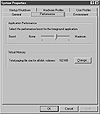| Previous | Table of Contents | Next |
Choosing The Best Video Adapter
Generally speaking, a network server’s video performance is not a high priority. Almost any video adapter will provide adequate performance. As long as the video adapter is 100 percent VGA compatible, it can be used with Windows NT Server. This is not to say, however, that it doesn’t matter what video adapter you use. Video performance can be important if you will be using the computer interactively to perform your basic management duties. After all, almost all of the administrative tools you will use are graphical in nature, and the speed of the video adapter can make a difference in how much work you get done on the server. So, what should you do?
At the very least, consider using a video card that will utilize your fastest I/O expansion bus. Hopefully, this will be a VESA or PCI bus. Next, consider using a video adapter that is also a graphics accelerator. A graphics accelerator can use any of the following methods to improve video performance:
- • Wider data paths to video memory
- • Faster video memory
- • A built-in coprocessor
- • Faster video memory
Most of today’s video adapters have 32-bit paths to video memory. Some have 64-bit paths, and the fastest have 128-bit paths. The wider the data path, the more information that can be read from or written to video memory in a given time. This directly relates to your ability to see changes appear on the monitor. As they say in the Grand Prix commercials, “Wider is Better”. For a car, a wider wheel base improves the car’s maneuverability. For a computer, a wider memory pathway provides improved throughput.
You can also achieve improved performance by making sure that your video card uses the fastest possible memory technology. The least expensive video accelerators use DRAM for their video memory. The mid-range video accelerators use VRAM (Video RAM), which is dual-ported memory (meaning it can be read and written to without a refresh cycle). The high-end video cards use WRAM (Windows RAM) or SDRAM for even better performance.
The most expensive video cards often include a video coprocessor. This processor is used to offload the workload from the computer’s CPU. Without a video coprocessor, your computer’s CPU must manipulate the video memory directly to draw lines, fill objects, and change colors. By offloading this work to a video coprocessor, your server can continue to perform more important work.
Another reason to use a faster video adapter is because you will want to use higher display resolutions. At a minimum, I recommend a display resolution of 1024×768 as this will allow you to view more data on screen (including multiple open windows). Higher resolutions also require faster video adapters to refresh the screen without long delays. This directly translates into improved user performance as you can accomplish more tasks on the server. Some of these tasks include modifying your server’s configuration immediately after you have installed it.
Modifying The Initial Installation
Right after you install Windows NT Server, you should launch the Control Panel System applet and make a few changes to improve overall system performance. The changes you make will determine how Windows NT Server allocates processor cycles to individual processes, how much virtual memory will be used by the system, and where these backing store (or paging) files will be located. Once the System Properties dialog box is displayed, select the Performance tab to display the property sheet shown in Figure 7.1.

Figure 7.1 Modifying the scheduling priorities.
This property sheet has two options: the Application Performance slider and the Virtual Memory Change button. The Application Performance slider is used to set the performance boost for the foreground application. It also assigns the runtime percentage of all the applications running on your system. This slider has three options ranging from None to Maximum. These settings, from left to right, directly translate to:
- • Foreground And Background Applications Equally Responsive—This setting gives every process the same priority and distributes the processor time equally among them. By distributing the processing time equally, it provides the optimum network performance. Although, this generally makes the server a very poor interactive partner because applications take quite a while to refresh the screen, and any network activity can bring your interactive usage to a crawl. This should not be a major problem because you can perform all administrative duties from your desktop if you install the client-based administrative tools included on your Windows NT Server CD-ROM. These tools are located in the \CLIENTS\SRVTOOLS subdirectory.
- • Foreground Application More Responsive Than Background—This setting is what I recommend you use if you plan to use this server interactively (maybe to create user accounts, add computer accounts, or other administrative duties), and it provides adequate response time but steals fewer processor cycles from the background applications.
- • Best Foreground Application Response Time—This setting offers the best performance for interactive use, but it is a poor choice for a server. What this setting does is steal processor cycles from your background processes (such as your Server service) to provide the best performance for the application you are currently using. This sure makes the application you are using perform well, but all other processes suffer.
- • Foreground Application More Responsive Than Background—This setting is what I recommend you use if you plan to use this server interactively (maybe to create user accounts, add computer accounts, or other administrative duties), and it provides adequate response time but steals fewer processor cycles from the background applications.
| Previous | Table of Contents | Next |